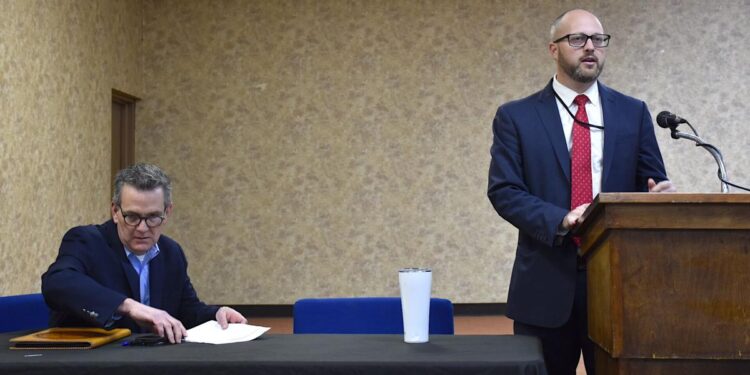The wheels began moving Friday when Southwest Oklahoma’s district attorneys and county commissioner representatives met at the Prairie Building at the Great Plains Coliseum to discuss an audacious and potentially historic idea.
It means uniting in an effort to create a regional facility to treat drug addiction.
District 5 District Attorney Kyle Cabelka, representing Comanche and Cotton counties, said things began with an idea 1½ to 2 years ago. He, District 6 District Attorney Jason Hicks, representing Caddo, Grady, Jefferson and Stephens counties; and District 2 District Attorney Angela Marsee, representing Beckham, Custer, Ellis, Roger Mills and Washita counties, spoke of the difficulties inherent in their roles as officers of the courts that stem from drug addiction.
A solution agreed upon by the trio and concurred by District 3 District David Thomas, representing Greer, Harmon, Jackson, Kiowa and Tillman counties, is for the development of a regional treatment and rehabilitation facility with the possibility of satellite centers to create a long-term solution to a devastating problem.
“We’re all very excited about this idea,” Cabelka said. “It’s not been done before in Oklahoma and I don’t know if it’s been done before in the nation.”
Cabelka said the goal is to broaden diversion efforts, a move that would take drugs off the street as well as lessen the impact drug addiction has on the state’s judicial and mental health systems.
“This is an idea I’m overly passionate about,” he said.
Hicks concurred with Cabelka and touted their districts’ intention to make the facility happen one way or another, even if on a smaller scale without buy in from the other districts.
“We know we have an opioid epidemic in Southwest Oklahoma,” he said. “We’ve got to do something to fix it. We really need to do something together.”
With facilities located in the Oklahoma City and Tulsa areas, those needing access in rural areas are often unable to get access to get away from addiction, Hicks said. For many people filling the jails, he said, treatment and rehabilitation are what can make a difference. As is, it strains the jail system and continues a cycle. He hoped all in attendance could see the need and seek to make a bold action.
“We’re going to do something that’s never been done in Oklahoma in the past,” he said. “This is really a starting point.”
Noting the counties are beginning to receive the opioid abatement settlement from the State Attorney General’s suits against Johnson & Johnson and other drug makers and distributors, Hicks said counties have the option of using their portions on their own. He hoped they would see that through unifying their monies into the proposed facility and program it would be able to make a real impact.
“This is a chance to do something phenomenal for Southwest Oklahoma,” he said. “This is something that needs to be done.”
“The need is there,” he continued. “The question begins with how are we going to meet those needs?”
After approaching the Comanche County Board of Commissioners, Cabelka said it was a first necessary step when they voted unanimously in February to retain the Center for Economic Development Law to provide professional services in connection with the formation and establishment of a public trust through a $5,000 allocation from the county’s opioid abatement settlement. It helps fund the legal effort needed to create a public trust among counties in Southwest Oklahoma, including Comanche County.
Lisa Harden and Jeff Sabin from the firm were present. Harden said the options are wide and that Friday was a good step in developing the particulars for a public trust authority but there’s more needed to “put meat into it.”
Declaring intent and providing a broad vision are key, Sabin said. He called the $5,000 allocation seed money for the project.
Marsee noted how some funds have been used to put in Narcan and opioid testing machines in communities. That’s effective. But, she said, she sees in court daily how the need for this trust is greater than that.
“We need to do something meaningful and long lasting,” she said.
Questions about how long the hundreds of millions of dollars in settlement money would be coming in came from commissioners in attendance. Hicks said that, along with available state and federal grants and funds saved through prison cost savings realized through the Smart Justice Reform Act, an ultimate success of the proposed program and facility would yield help from the state legislature. It’s a big investment.
“It’s going to take a big sum to start up,” he said. “I feel the state will invest in it if it works.”
Cabelka said he’s asking Comanche and Cotton counties to invest 100 percent of their settlement proceeds to the endeavor. He encouraged other participating counties to do the same but hoped, if nothing else, they would contribute a large percentage of funds.
With a March 29 grant deadline coming up, action is needed by the counties urgently, according to Cabelka. His Assistant District Attorney Kelli Woodson has been working on the district’s grant applications. She said other counties participating could use it as a template. Joined with a letter of intent for the trust’s formation, it would grant some extra time.
Marsee noted that the grants allow for remediation and abatement to opioids’ impact. That means, not only that singular addiction but use and abuse of others drugs that come with it.
It’s about treatment across the board, Hicks said. That’s a “long-term process.”
“It’s not just opioids,” he said. “There’s a very serious drug problem across Oklahoma, across the nation.”
Chris Schroder, executive director for the Association of County Commissioners, said he believed the burgeoning trust authority was onto something beneficial that will have historic significance and prove to be a model throughout the state and, possibly, nation.
“I think this is great,” he said. “If you create a successful project, they (legislature) will fund it; I think it’s a good model.”
While the Districts 2 and 3 county commissioners will have to meet, discuss and decided whether or not to participate, those in attendance see the need and plan to return to the next meeting with action taken.
Comanche County District 2 Commissioner Johnny Owens said it was time to do something.
“Let’s just move forward,” he said.
Another meeting will be called soon and its mission will be to set up the structure of the project and create the subcommittee so that action can be streamlined, Hicks said. He looked at the assembled faces in the room and noted the cadre of influence throughout Southwest Oklahoma there to tackle this problem.
“Time is really of the essence,” he said. “We’re going to make this happen.”
Want to reach a local audience and grow your business?
Our website is the perfect platform to connect with engaged readers in your local area.
Whether you're looking for banner ads, sponsored content, or custom promotions, we can tailor a package to meet your needs.
Contact us today to learn more about advertising opportunities!
CONTACT US NOW




